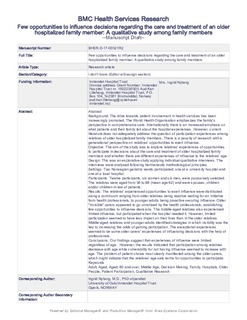| dc.contributor.author | Nyborg, Ingrid | |
| dc.contributor.author | Danbolt, Lars Johan | |
| dc.contributor.author | Kirkevold, Marit | |
| dc.coverage.spatial | Norway | nb_NO |
| dc.date.accessioned | 2018-06-01T11:19:18Z | |
| dc.date.available | 2018-06-01T11:19:18Z | |
| dc.date.created | 2017-11-01T15:17:37Z | |
| dc.date.issued | 2017 | |
| dc.identifier.citation | BMC Health Services Research. 2017, 17 (619), . | nb_NO |
| dc.identifier.issn | 1472-6963 | |
| dc.identifier.uri | http://hdl.handle.net/11250/2500045 | |
| dc.description | Citation: Nyborg et al. BMC Health Services Research (2017) 17:619 DOI 10.1186/s12913-017-2563-y | nb_NO |
| dc.description.abstract | Background The drive towards patient involvement in health services has been increasingly promoted. The World Health Organisation emphasizes the family’s perspective in comprehensive care. Internationally there is an increased emphasis on what patients and their family tell about the hospital experiences. However, current literature does not adequately address the question of participation experiences among relatives of older hospitalized family members. There is a paucity of research with a generational perspective on relatives’ opportunities to exert influence. The aim of the study was to explore relatives’ experiences of opportunities to participate in decisions about the care and treatment of older hospitalized family members and whether there are different experiences of influence to the relatives’ age. Methods This was an explorative study applying individual qualitative interviews. The interviews were analysed following hermeneutic methodological principles. Two Norwegian geriatric wards participated: one at a university hospital and one at a local hospital. Twelve participants, six women and six men, were purposively selected. The relatives were aged from 36 to 88 (mean age 62) and were spouses, children and/or children-in-law of patients. Results The relatives’ experienced opportunities to exert influence were distributed along a continuum ranging from older relatives being reactive waiting for an initiative from health professionals, to younger adults being proactive securing influence. Older “invisible” carers appeared to go unnoticed by the health professionals, establishing few opportunities to influence decisions. The middle-aged relatives also experienced limited influence, but participated when the hospital needed it. However, limited participation seemed to have less impact on their lives than in the older relatives. Middle-aged relatives and younger adults identified strategies in which visibility was the key to increasing the odds of gaining participation. The exceptional case seemed to be some older carers’ experiences of influencing decisions with the help of professionals. Conclusions Our findings suggest that experiences of influence were limited regardless of age. However, the results indicated that participation among relatives decrease with age while vulnerability for not having influence seemed to increase with age. The problem of patient choice most clearly manifested among the older carers, which might indicate that the relatives’ age sets terms for opportunities to participate. | nb_NO |
| dc.description.sponsorship | The study was approved by the Regional Committee for Medical and Health Research Ethics South East Ref. 2012/1598. This study was funded by Innlandet Hospital Trust in Norway. | nb_NO |
| dc.language.iso | eng | nb_NO |
| dc.rights | Navngivelse 4.0 Internasjonal | * |
| dc.rights.uri | http://creativecommons.org/licenses/by/4.0/deed.no | * |
| dc.subject | Adult | nb_NO |
| dc.subject | Aged | nb_NO |
| dc.subject | Aged, 80 and over | nb_NO |
| dc.subject | Middle age | nb_NO |
| dc.subject | Decision making | nb_NO |
| dc.subject | Family | nb_NO |
| dc.subject | Hospitals | nb_NO |
| dc.subject | Older people | nb_NO |
| dc.subject | Patient | nb_NO |
| dc.title | Few opportunities to influence decisions regarding the care and treatment of an older hospitalized family member: A qualitative study among family members | nb_NO |
| dc.type | Journal article | nb_NO |
| dc.type | Peer reviewed | nb_NO |
| dc.description.version | acceptedVersion | nb_NO |
| dc.rights.holder | © The Author(s). 2017 Open Access This article is distributed under the terms of the Creative Commons Attribution 4.0 International License (http://creativecommons.org/licenses/by/4.0/), which permits unrestricted use, distribution, and reproduction in any medium, provided you give appropriate credit to the original author(s) and the source, provide a link to the Creative Commons license, and indicate if changes were made. The Creative Commons Public Domain Dedication waiver (http://creativecommons.org/publicdomain/zero/1.0/) applies to the data made available in this article, unless otherwise stated. | nb_NO |
| dc.source.pagenumber | 12 | nb_NO |
| dc.source.volume | 17 | nb_NO |
| dc.source.journal | BMC Health Services Research | nb_NO |
| dc.source.issue | 619 | nb_NO |
| dc.identifier.doi | 10.1186/s12913-017-2563-y | |
| dc.identifier.cristin | 1509937 | |
| cristin.unitcode | 1991,0,0,0 | |
| cristin.unitcode | 1991,9,0,0 | |
| cristin.unitname | Sykehuset Innlandet HF | |
| cristin.unitname | Div Psykisk helsevern | |
| cristin.ispublished | true | |
| cristin.fulltext | postprint | |
| cristin.qualitycode | 2 | |

